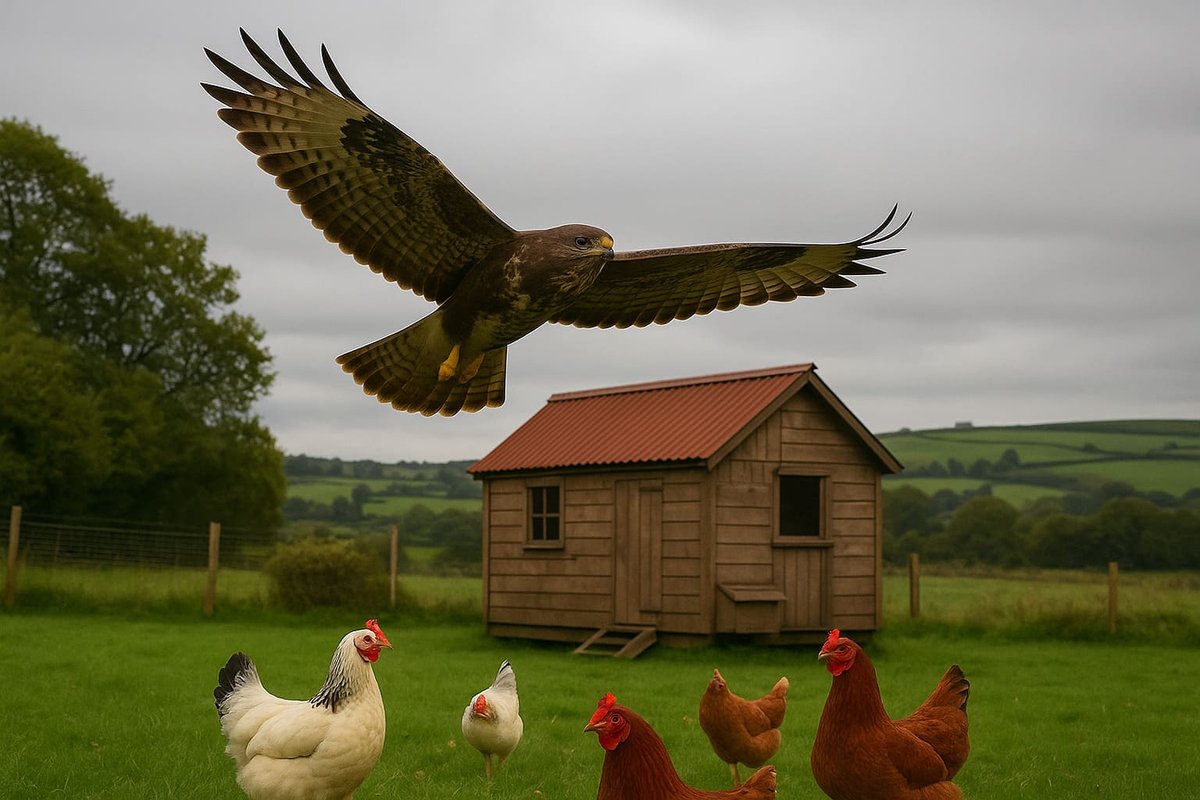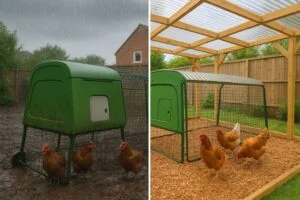Buzzards, magpies, and crows all pose threats to UK backyard chickens, but each bird requires different protection strategies.
Buzzards, magpies, and crows all pose threats to UK backyard chickens, but each bird requires different protection strategies. Buzzards can carry off small chickens, magpies attack chicks and steal eggs, while crows are opportunistic scavengers that rarely kill healthy adult birds.
I’ve kept backyard chickens in rural Gloucestershire for nine years, managing a mixed flock of twelve birds including Light Sussex and Pekin bantams. After losing three young pullets to a buzzard in spring 2023, I spent two years testing every protection method I could find. I’ll share what actually works in British gardens without breaking UK wildlife laws.
This guide covers proven deterrent techniques used by hundreds of UK chicken keepers, legal considerations under the Wildlife and Countryside Act 1981, and practical solutions for gardens of all sizes. You’ll learn how to identify real threats, install effective barriers, and choose the best protection method for your specific situation.
Important: All birds of prey and most wild birds in the UK are legally protected. The methods in this guide focus on deterrence and prevention, never harm.
Let’s start by understanding which UK birds actually threaten your flock.
Understanding UK Birds of Prey Threats to Chickens
Before you spend money on deterrents, it’s vital to know what you’re up against. A magpie and a buzzard are both avian threats, but they hunt differently and require completely different solutions. You can find detailed identification guides at the RSPB wildlife guidance hub.
Will a Buzzard Take a Chicken?
Yes, a buzzard can and will take a chicken, especially small bantams and young pullets. The Common Buzzard (Buteo buteo) is the UK’s most common bird of prey, and while its main diet is rabbits and rodents, it’s an opportunist. According to British Trust for Ornithology (BTO) data, the Common Buzzard is now the UK’s most common bird of prey, with BTO data showing a 78% population increase since 1995, making them a more common threat to backyard flocks than in previous decades.
In my experience, buzzards are boldest in spring when they are feeding their young.
Are Magpies a Threat to Chickens?
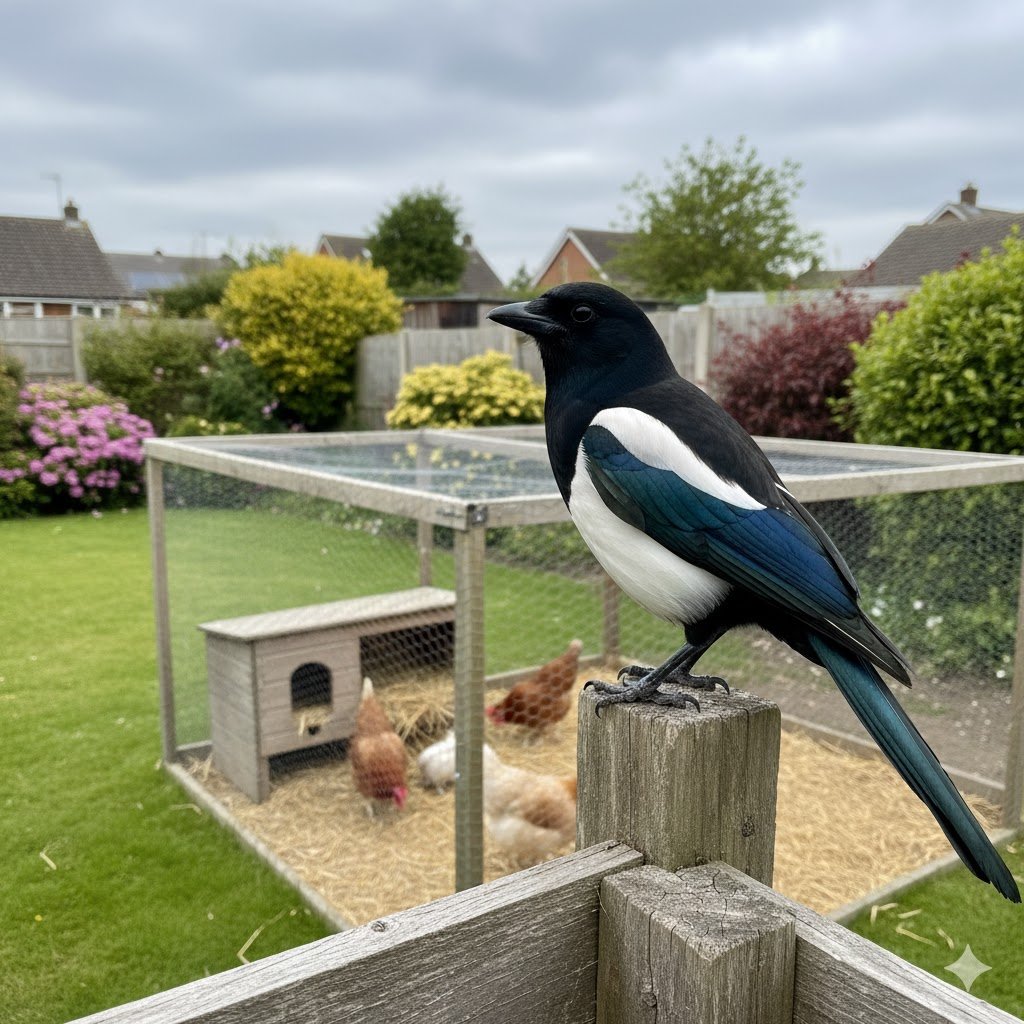
Magpies are a different kind of threat. Magpies (Pica pica) are part of the corvid family, along with crows and ravens. They are incredibly intelligent—according to corvid family behavior research, they are among the most intelligent birds, capable of problem-solving and learning human routines—but they rarely attack a healthy, adult chicken.
Their main targets are eggs and very young chicks. A magpie will boldly walk into a coop to steal eggs and will snatch a chick given the slightest chance. They are more of a serious nuisance and a threat to your flock’s future, rather than a direct threat to your adult birds.
Do Crows Protect Chickens? (Myth Busting)
No, crows do not protect chickens. You might be wondering where this common misconception comes from, as I hear it a lot.
This myth likely comes from people seeing crows “mobbing” a larger bird of prey, like a buzzard or a red kite. When crows do this, they are defending their own territory and nests from a predator, not protecting your flock. Crows are opportunistic and will just as happily steal your chicken’s food or even their eggs if they get the chance.
What Animals Kill Chickens in the UK (Complete List)
It’s easy to blame the birds you can see, but many attacks happen when you’re not looking. To properly protect your flock, you need to know all the potential threats in the UK. Foxes are, by far, the biggest killer of backyard chickens.
Here’s a quick identification guide.
| Predator | Active Time | Evidence Left | Risk Level |
|---|---|---|---|
| Fox | Dusk, Night, Dawn | Many feathers, multiple dead birds (often uneaten), bird may be missing, body parts buried. | Very High |
| Common Buzzard | Daytime | Single bird missing, or found partially eaten nearby. | Medium (High for bantams) |
| Badger | Night | Messy attack, often breaks into weak coops. Will eat bird on-site, including bones. | Medium |
| Magpie / Crow | Daytime | Eggs missing, small chicks missing. Will attack weak or sick adult birds. | Low (High for chicks/eggs) |
| Stoat / Weasel | Day or Night | Very small entry hole, birds killed with a bite to the neck, often leaves a neat pile of dead birds. | Medium (High for chicks) |
| Tawny Owl | Night | Rare. May take a small bantam left out at night. | Low |
According to the British Hen Welfare Trust (BHWT), UK chicken predators include foxes, badgers, rats, ferrets, and buzzards, with foxes being the primary threat.
How Birds of Prey Hunt Chickens (What You Need to Know)
Understanding how a predator hunts is the key to stopping it. Here’s what actually happens. A net that stops a magpie will not stop a fox, and a fence that stops a fox will do nothing to stop a buzzard.
Daytime Hunters (Buzzards, Hawks, Magpies)
Buzzards and hawks (like the Sparrowhawk, which sometimes attacks bantams) are classic “sit and wait” predators. They will perch in a high tree or on a fence post, watching your flock for long periods. They look for a bird that is isolated, young, or appears weak. They attack from above, using speed and surprise.
Magpies and crows are different. They are bold and clever. They will walk right up to your run, test for weaknesses, and watch your routine. They learn when you collect the eggs and when the chicks are out.
What Kills Chickens at Night and Leaves Them
If you find a dead chicken at night, the number one suspect is always a fox. Foxes often engage in “surplus killing,” where they kill all the birds in a coop but only take one or two, leaving the rest.
However, if a single, small bird is killed and left, it’s possibly an owl. Tawny Owls (Strix aluco) are common across the UK and are capable of killing a small bantam, but it’s not common. The best defence against all night-time predators is simple: a strong, secure coop that you lock every single night before dusk.
While this guide focuses on aerial threats, remember that foxes are the UK’s primary chicken killer. You can learn about fox-proof coop designs that protect your flock at night.
How to Protect Chickens from Magpies and Crows: Proven Methods
Because magpies and crows (corvids) are smart and persistent, your protection needs to be just as smart.
Overhead Netting and Barriers
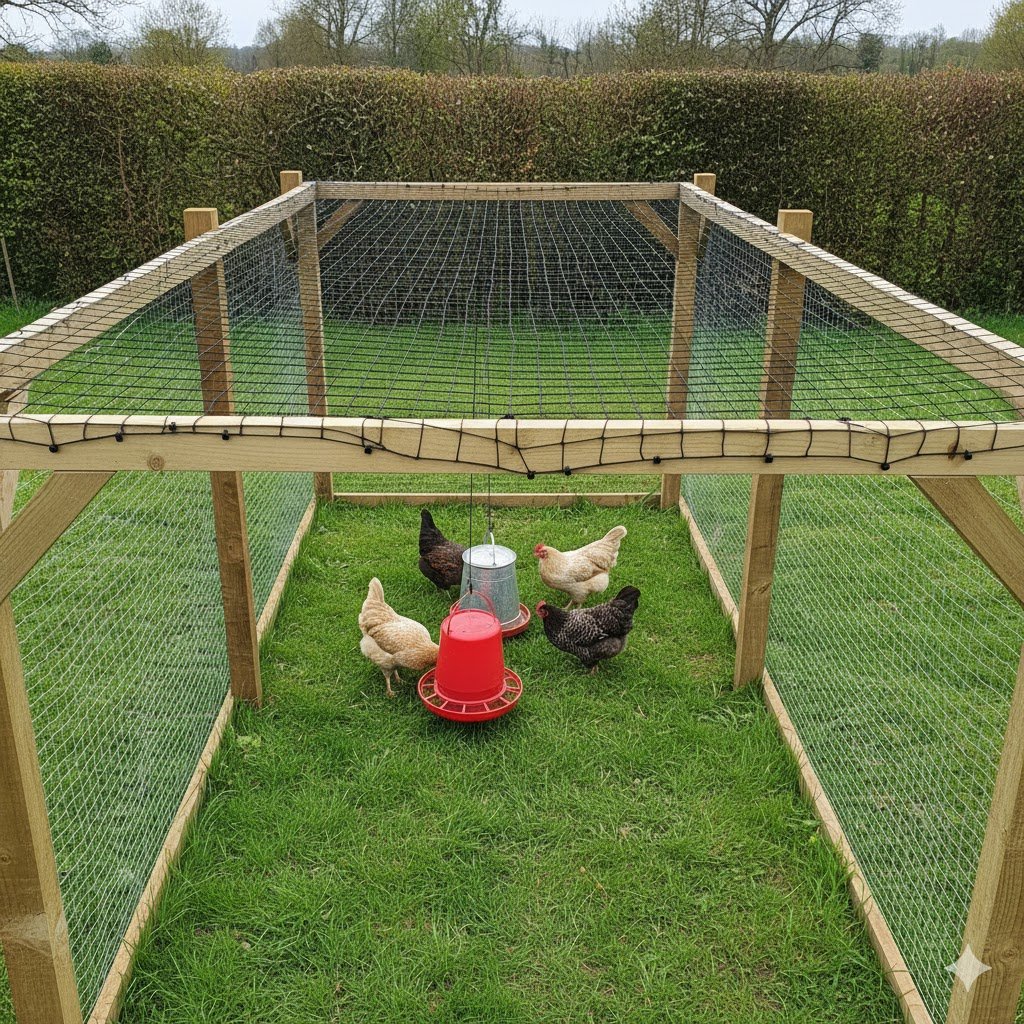
This is the most effective method. Cheap fruit netting will not work; it will rip, and birds will get tangled in it. You need proper, UV-stable poultry netting.
How to Install It (Simple Listicle):
- Get the Right Materials: You’ll need tall posts (at least 6-7 feet high), strong UV-resistant netting (like 20mm mesh), and plenty of zip ties or garden wire.
- Set Your Posts: Place posts around the perimeter of your chicken run, no more than 10-12 feet apart.
- Add a Centre Support: For larger runs, run a line of strong wire (a “straining line”) from one side to the other, over a central post, to support the net’s weight and prevent sagging.
This type of netting also helps stop your chickens from flying over the fence and leaving the protected zone.
Reflective Deterrents (Do They Work?)
You’ll see many UK keepers hanging old CDs, small mirrors, or holographic “scare tape.” Here’s the truth based on my experience: these work, but only for a short time.
Magpies and crows are neophobic (afraid of new things). The flashing light and movement will scare them off for a few days, maybe even a week. But they are smart, and they will eventually realise the shiny object is not a threat. Use them for temporary protection, but don’t rely on them long-term.
How to Stop Crows and Magpies from Eating Bird Food
Often, the birds are after the free, high-protein food, not your flock.
- Use Treadle Feeders: These feeders only open when a chicken stands on the plate. They are too heavy for magpies or rats to operate. These feeders also prevent rat access—read our complete guide to keeping rats out of your chicken coop.
- Feeder Placement: Place feeders under cover or inside the coop, not out in the open where they act as a beacon.
- What smell do crows hate most? There is no scientific evidence that home remedies like coffee grounds deter crows or magpies—this is a garden myth. While capsaicin (chilli pepper heat) is sometimes suggested, the evidence is weak and impractical. Birds generally don’t react to capsaicin the way mammals do, making it unreliable. Stick to secure feeders instead.
- Secure Your Feed: Choose high-quality UK poultry feed brands and store them in secure, corvid-proof containers (like metal bins) to reduce attraction to your property.
Protecting Your Flock from Buzzards (Raptor-Specific Solutions)
Buzzards are a protected species and a more powerful, determined predator. Your defences need to be stronger.
Legal Considerations (UK Wildlife Law)
This is critical: All UK birds of prey are legally protected under the Wildlife and Countryside Act 1981.
It is a criminal offence to intentionally kill, harm, trap, or disturb a buzzard or its nest, as they are protected under Schedule 1 of this Act. The penalties are severe, including large fines and even imprisonment. All the methods we discuss must be non-harmful, legal deterrents.
Overhead Protection Systems
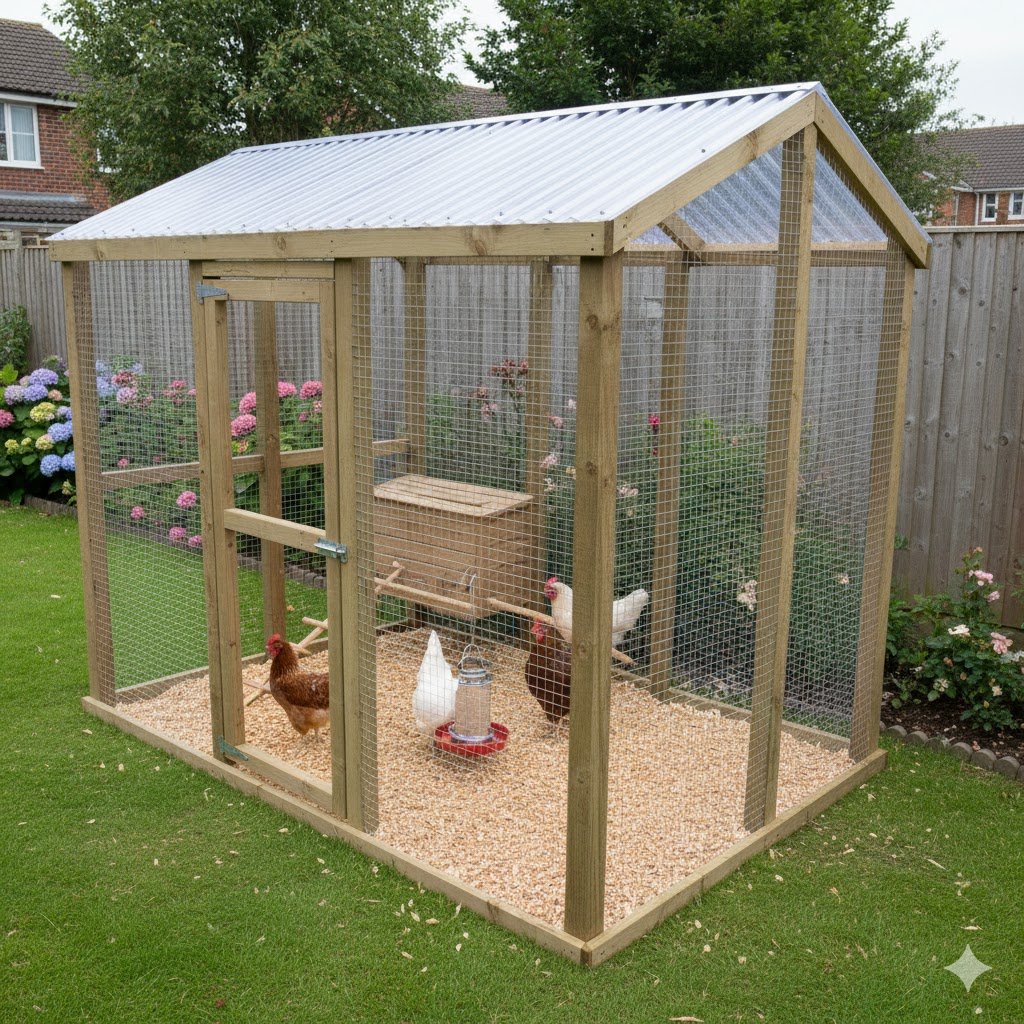
For a raptor, the only 100% solution is a 100% barrier.
- Covered Runs: This is the gold standard. A permanent, solid (e.g., clear corrugated plastic) or “hardware cloth” (strong wire mesh) roof on your run is the only way to guarantee no aerial predator can get in. For UK chicken keepers considering a permanent solution, walk-in runs with overhead protection offer excellent buzzard deterrence while allowing you easy access.
- Fishing Line Barriers: This is a cheaper method I’ve had success with. String high-strength fishing line in a tight crisscross pattern (about 1-2 feet apart) over the top of the run. Buzzards have large wingspans and hate diving into tight, enclosed spaces where they might get tangled. They can’t see the line easily and will avoid the area.
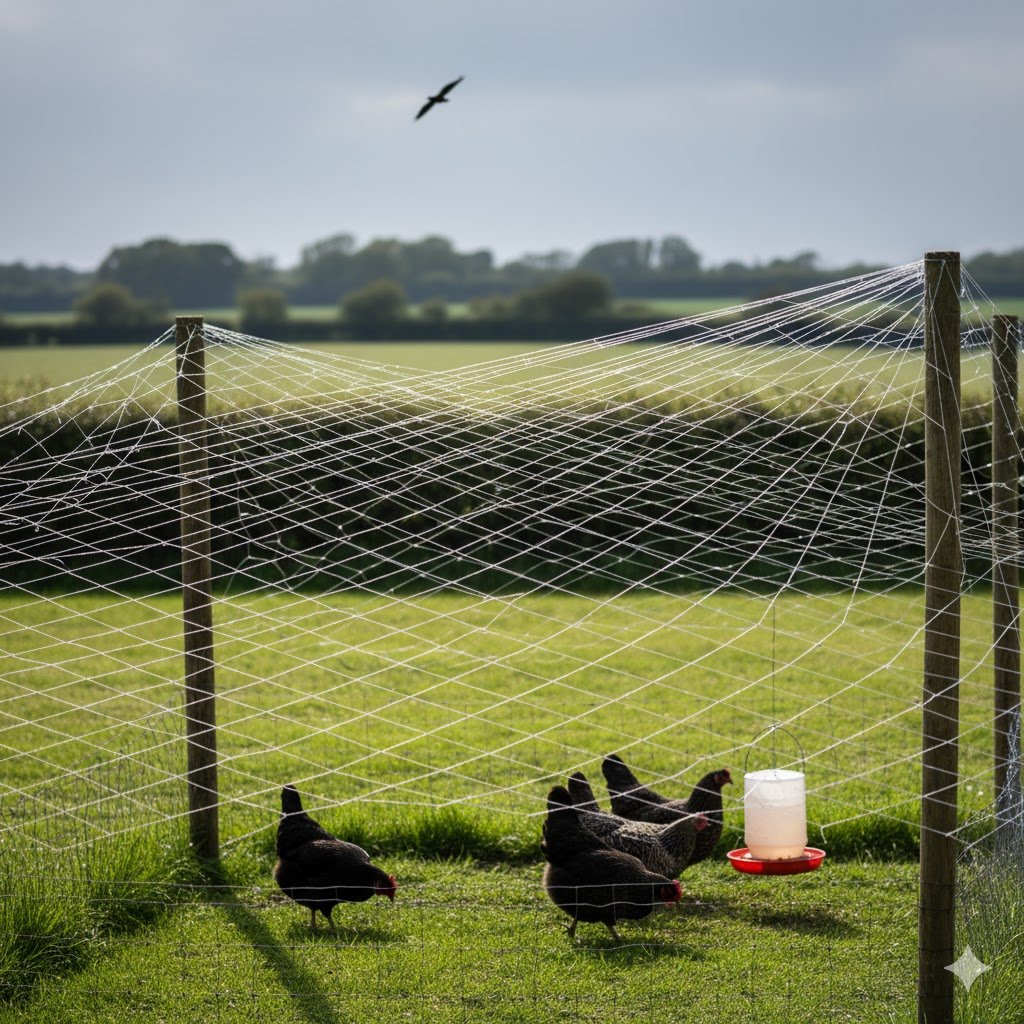
Protection System Comparison
| Method | Est. Cost (4m x 4m run) | Effectiveness | Installation |
|---|---|---|---|
| Full Covered Run | £200 – £500 | 100% | High (1-2 days) |
| Poultry Netting | £60 – £120 | 95% | Medium (2-3 hours) |
| Fishing Line | £20 – £30 | 80-90% | Low (1 hour) |
Providing Cover and Shelter
Buzzards won’t dive into a space they can’t easily fly out of. If your chickens free-range, you must provide “safe zones.”
- Natural Cover: Planting dense shrubs, small trees, or bushes in their ranging area gives them a place to dash for safety.
- Artificial Shelters: Even a simple lean-to made from a sheet of wood, or a low table they can hide under, can be enough to deter a buzzard who wants an easy meal.
Overhead barriers are just one element of a completely predator-proof coop system. Ensure your entire setup, from the ground up, meets UK security standards.
A Note on Avian Influenza (Bird Flu) Biosecurity
As of 2025, all UK chicken keepers must also follow current UK biosecurity requirements due to Avian Influenza Prevention Zones. Even when a full “housing order” isn’t in place, these rules remain. This includes a legal requirement to prevent wild birds from accessing your flock’s feed and water, and using netting or fencing to stop wild birds from entering your chicken enclosures. These biosecurity measures are a key part of a complete poultry biosecurity plan and go hand-in-hand with your predator protection strategies.
Best Animals to Protect Chickens from Predators
Sometimes, the best defence is a good guardian animal. This is a big commitment but can be very effective. Beyond predator protection, UK chicken keepers must also address biosecurity threats like red mites in wooden coops, which weaken birds and make them more vulnerable to attack.
Livestock Guardian Dogs (LGDs)
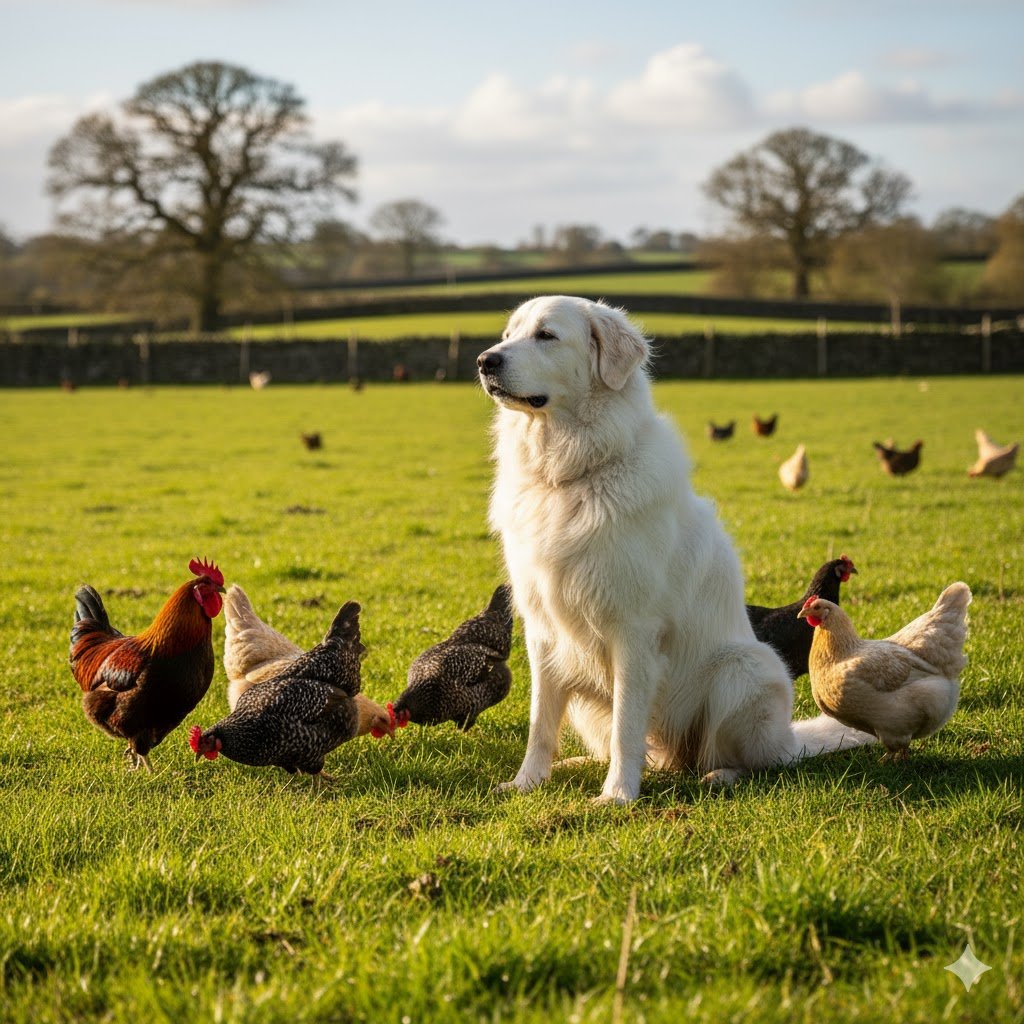
These are not pets. Breeds like Maremmas or Pyrenean Mountain Dogs are bred to live with and protect livestock. This is a serious, full-time commitment and is not suitable for most small UK gardens. They require specific training to bond with the chickens.
Roosters (Cockerels) as Sentries
A cockerel (the UK term for a rooster) is the traditional flock protector. His job is to watch the sky and the surrounding area. If he spots a threat, he will sound a loud, specific alarm call, and the hens will run for cover. He may even fight a predator, though he would lose against a buzzard or fox.
The main problem in the UK is noise. Cockerels crow, a lot. Before you get one, check your local council’s regulations on “noise nuisance.”
Guinea Fowl and Geese
Both geese and guinea fowl are fantastic “alarm systems.” They are loud, aggressive, and will raise an incredible racket at the slightest sign of a threat—whether it’s a buzzard, a fox, or the postman. They can be good companions for a flock, but they are also very noisy and can be aggressive towards you or your chickens.
A good strategy is to combine guardian animals with electric fencing for comprehensive protection against both ground and aerial predators.
Guardian Animal Comparison
Here’s a quick comparison of the most common guardian animals for UK flocks.
| Animal | Effectiveness | UK Garden Suitability | Noise Level | Cost |
|---|---|---|---|---|
| Livestock Guardian Dog | Very High | Low (needs space) | Medium | High |
| Cockerel | Medium-High | Medium (noise rules) | Very High | Low |
| Guinea Fowl | Medium | Medium | Very High | Medium |
| Geese | Medium | Medium-High | High | Medium |
Complete Predator-Proofing Checklist for UK Flocks
Here is a simple, actionable checklist you can use every day.
- Morning Routine:
- Before letting the birds out, walk the perimeter of the run. Look for signs of digging or wire-pulling.
- Check overhead netting for any rips or sags from overnight wind or rain.
- Change their food and water inside the secure run or coop, not out in the open.
- Evening Routine:
- Lock your chickens in their secure, solid-sided coop before dusk. This is the single most important thing you can do to stop foxes and owls. Using one of the best automatic chicken coop doors available in the UK can automate this crucial step.
- Do a head-count every night to make sure all birds are accounted for. If you have trouble, here are some tips on how to get chickens back in the coop at night.
- Seasonal Checks:
- Spring: Be extra vigilant. This is when buzzards, hawks, and magpies are all feeding their young and are at their boldest.
- Autumn/Winter: Check your coop and run for any storm damage (fallen branches, broken panels) that could create an entry point. This is a key part of any chicken coop winterizing guide. In wet weather, review ways to fix a muddy chicken run to keep your flock healthy.
- Legal Check (One-Time):
- Remember: All UK poultry keepers must register their flock with DEFRA, regardless of flock size. This is a legal requirement and ensures you receive important disease outbreak notifications in your area.
Frequently Asked Questions on Protecting Your Flock from UK Birds of Prey
What is the most aggressive bird in the UK toward chickens?
For healthy adult chickens, the Common Buzzard is the most dangerous and aggressive. For eggs and small chicks, the Magpie is the most common and persistent threat.
Why should I sprinkle coffee grounds around my bird feeder?
There is no scientific evidence that coffee grounds deter crows or magpies—this is a garden myth. While capsaicin (chilli pepper heat) is sometimes suggested, the evidence is weak and impractical. Birds generally don’t react to capsaicin the way mammals do, making it unreliable. You are better off using a secure, treadle feeder.
How do I get rid of crows but not other birds?
This is very difficult as they are all part of the same ecosystem. The best way is to make your garden less attractive to them. Focus on “crow-proof” bird feeders (like cage-style feeders) that use weight or size to exclude larger birds, and never leave chicken food or scraps out in the open.
Do I need a covered run for UK birds of prey?
If you live in a rural area with a known buzzard population and you keep small bantam breeds, a covered run is the safest, most effective solution. For larger hens, providing plenty of natural cover and using fishing line barriers may be enough.
Conclusion: A Safe Flock is a Happy Flock
Protecting your flock from UK birds of prey—and other predators like foxes—isn’t a single task, it’s an ongoing habit. As a keeper who has learned the hard way, I can tell you the best defence is a layered one.
It starts with a rock-solid coop to stop foxes and owls at night. Then, it’s about securing the run from aerial threats like buzzards with netting, and ground threats like magpies with smart feeders. For more tips, check out these predator-proofing 101 easy fixes. By combining these physical barriers with a daily routine of checking your setup, you can give your chickens a safe and happy life, all while respecting our protected UK wildlife.
Your Next Steps: A Simple Action Plan
Feeling overwhelmed? Don’t be. The best protection is built one step at a time. Here’s what you can do today:
- Start with a perimeter check: This evening, before you lock up your flock, walk the entire perimeter of their run. Look for gaps, signs of digging, or weak points.
- Measure your run: Grab a tape measure and find out the exact dimensions of your run. This will help you calculate how much netting or wire you actually need.
- Check local council regulations: Before you consider a cockerel, spend five minutes on your local council’s website to check their rules on “noise nuisance.”

Oladepo Babatunde is the founder of ChickenStarter.com. He is a backyard chicken keeper and educator who specializes in helping beginners raise healthy flocks, particularly in warm climates. His expertise comes from years of hands-on experience building coops, treating common chicken ailments, and solving flock management issues. His own happy hens are a testament to his methods, laying 25-30 eggs weekly.
